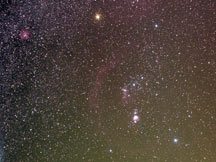Orion. 12x5min (1hr total) with 24mm f/2.8 Zuiko lens stopped down to f/4, on the ST2000XCM camera. Stacked in Registax3. I used a wide aperature to maximize signal for this very faint nebulosity (in skies with occasional light cirrus drifting and lit by the lights of Santa Cruz). Led to strong comatic aberration needing heavy post-processing in Photoshop CS2. Lots of blue and green faint stars were fixed with liberal use of the replace color command. Then AstroTools 'make stars smaller', 'deep space noise reduction', then PS smart sharpen, levels. I'm a little disappointed, but realize that those awesome shots on the web are shot with H-alpha filters which dramatically isolate Barnard's Loop vs the stars. It's VERY faint.



